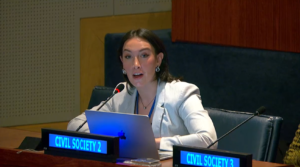On March 19, 2025, Human Rights Now was selected to make an intervention at the “Interactive Dialogue on Environmental conservation, protection, and rehabilitation” held at the United Nations Headquarters in New York City.
The recording is available on UN Web TV.
The transcript of the intervention is as follows.
________________________________________
Today, I highlight the urgent intersections of gender, environmental degradation, and the leadership of women in Japan and East Asia. Women in these regions are not only stewards of their lands and waters, but also frontline defenders against toxic pollution, climate change, and environmental destruction.
The Special Rapporteur on Toxics, who I had the opportunity to meet with yesterday, has warned that women—particularly Indigenous women, fisherfolk, and informal workers—face disproportionate exposure to hazardous chemicals and pollution, often with devastating health consequences.
In Japan, the fight for justice in the wake of Minamata disease demonstrated how women-led advocacy was crucial in holding industries accountable.
In Bangladesh, women working in the textile industry face daily exposure to toxic dyes and chemicals, with little legal protection or medical support.
In Myanmar, land grabs, illegal logging, and mining—particularly for rare earth minerals—are displacing Indigenous and rural communities, stripping women of their livelihoods and exposing them to environmental toxins without consultation or consent.
Despite these injustices, women are leading change.
In Bangladesh, women in coastal areas are pioneering mangrove restoration to protect against rising sea levels.
In Myanmar, women’s groups are resisting environmental destruction by defending Indigenous land rights, often at great personal risk.
From anti-nuclear activism in Japan to community-led resilience efforts across the region, women are shaping sustainable solutions.
Informed by the women human rights defenders working to protect our world, Human Rights Now recommends the following:
1. Legally Binding Protections Against Toxic Exposure
Implement and enforce stronger environmental and labor regulations to protect women in agriculture, manufacturing, and extractive industries from hazardous substances. This includes national legislation, an example being Japan’s Chemical Substances Control Law, as well as international legislation, including the Basel Convention, the Rotterdam Convention, the Stockholm Convention, and ILO Convention 170.
Strengthen corporate accountability for pollution and environmental harm, including legal remedies for affected communities, through domestic and regional litigation.
2. Direct Climate and Environmental Financing for Women-Led Initiatives
Ensure that at least 50% of climate adaptation funds, including the Green Climate Fund (GCF), the Adaptation Fund (AF), and the Global Environment Facility (GEF) Trust Fund reach grassroots, women-led environmental conservation efforts.
3. Recognition and Inclusion of Women in Environmental Decision-Making
Guarantee women’s full and equal participation in environmental governance, climate negotiations, and resource management policies at all levels.
Strengthen Indigenous women’s land rights, especially in regions where extractive industries and deforestation are displacing communities. The work on climate and women established during CSW should directly translate to the Permanent Forum on Indigenous issues to be held here in NYC in April.
4. Implementation of the Special Rapporteur’s Gender-Responsive Policies
Recognize toxic exposure as a gendered issue and ensure gender-sensitive monitoring, reporting, and accountability mechanisms.
Provide accessible healthcare, compensation, and justice mechanisms for women harmed by toxic pollution.
We have one of the most prominent experts in the world who just wrote a report on the intersection between gender and toxics. We must listen to his findings and implement his recommendations.
As we convene at CSW69, let us recognize that gender justice and environmental protection are inseparable. Women in Japan, Myanmar, Bangladesh, and across East Asia are not just victims of environmental harm; they are architects of solutions. It is time to listen, invest, and act.
Thank you.
____________________________________________________________




